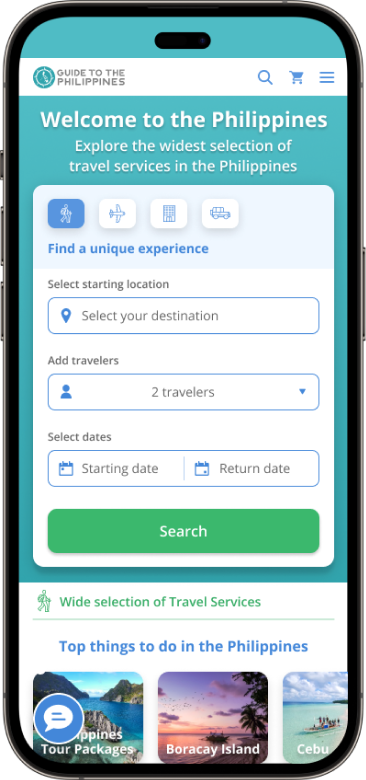
Best Tours & Activities in the Philippines
Select destination
Select dates
Add travelers
Top things to do in the Philippines
Discover all the adventures you can experience in the Philippines
Popular trips in the Philippines
Explore our featured day tours in the Philippines
Popular Day Tours and Transfers
Choose among the most popular tours and transfers in the Philippines
Why Choose The #1 Travel Platform in the Philippines
Discover the advantages that make us the most trusted choice for your adventure in the Philippines
The Philippines’ Leading Travel Marketplace
Best Price Guarantee
Expert Local Guidance
Largest Selection of Tours in the Philippines
Free Cancellation on All Tours
Multilingual 24/7 Customer Support
Newest Tours
Be among the first to find and book the newest tours in the Philippines
Explore an unequalled wealth of tours and packages
Frequently asked questions
Whether you’re a nature lover or a thrill-seeker, you will enjoy the Puerto Princesa Underground River Tours. As one of the New 7 Wonders of the World and a UNESCO World Heritage Site, the Underground River’s cave system and spectacular rock formations will mesmerize you.
On Cebu Island, don't miss the opportunity to swim with gentle giants by joining whale shark-watching tours. It's an unforgettable experience where you can get up close to these magnificent creatures in their natural habitat. For adventure seekers, the canyoneering tours at Kawasan Falls offer an exhilarating mix of trekking, swimming, and cliff jumping in one of Cebu Island's most beautiful spots.
On Bohol Island, the Chocolate Hills tours will take you to the scenic countryside to witness a natural wonder—hills that transform into a rich brown during the summer. Along the way, you'll also have the chance to meet the island's famous and adorable tiny monkeys, the tarsiers.
Meanwhile, culture enthusiasts can immerse themselves in history by joining tours to Intramuros Oldtown in Manila City. This tour walks you through the historic walled city, offering insights into the Philippines' rich colonial past.
These are just a few examples of the incredible tours and things to do in the Philippines that make the country a must-visit destination.
Among these are Boracay Island, famous for its white sand beaches and crystal-clear waters; Palawan Island, home to some of the country’s most beautiful snorkeling spots, lagoons, and limestone cliffs; Siargao Island, the surfing capital of the Philippines and a laid-back beach destination; Bohol Island, known for the iconic Chocolate Hills; and Cebu Island, where you can interact with whale sharks, turtles, and millions of sardines, or embark on an epic river canyoneering adventure.
These are just a few of the many stunning places in the country. Read the ultimate list of the best places to visit in the Philippines.
To secure the best rates, it’s wise to book your tours online in advance. By reserving with Guide to the Philippines ahead of your trip, you'll access great deals and ensure a seamless, enjoyable vacation experience. Plan ahead and embark on your adventure with confidence!
To ensure a smooth and enjoyable vacation, it’s wise to book your tours and flights to the Philippines in advance. Read the guide on the cheapest month to fly to the Philippines for more practical tips on the best time to visit the country.
When you book a trip with Guide to the Philippines, a travel agent will assist you with the process of obtaining your tourist visa. Check out the widest selection of vacation packages in the Philippines. With all the details pre-arranged for you, you can enjoy a stress-free holiday at top beaches and islands in the country.
Read the comprehensive guide on getting around the Philippines.
If you have the time for a longer stay, spending three to four weeks in the Philippines opens up a world of incredible experiences. You'll have the chance to dive deep into the country’s rich history, uncover hidden gems, marvel at breathtaking natural wonders, and truly relax in paradise. Whether you're craving adventure, cultural exploration, or a tranquil escape on pristine beaches, the Philippines offers it all.
To ensure a seamless and unforgettable vacation, book a tour package with Guide to the Philippines. Choose from a wide range of thoughtfully crafted itineraries in the Philippines, with flexible durations tailored to your preferences. With all the details taken care of, you can unwind and savor a stress-free holiday at the country’s most stunning beaches and islands.
Whether you prefer the exclusivity of a private tour or the social experience of a group outing, Guide to the Philippines offers a wide selection of tours to match your style.
With Guide to the Philippines, booking these cultural tours in advance ensures a deep and memorable connection with the country’s unique heritage while securing the best rates and availability.
Consider adding UNESCO Heritage Sites in the Philippines, as well as record-holding attractions, to your itinerary.

Download the Philippines’ biggest travel marketplace to your phone to manage your entire trip in one place
Scan this QR code with your phone camera and press the link that appears to add the Philippines’ biggest travel marketplace into your pocket. Enter your phone number or email address to receive an SMS or email with the download link.







































































